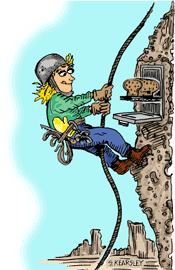|
Monthly Feature:


The weight of air is a phenomenon most cooks seldom contemplate. But if you live in Denver, Calgary, Johannesburg, or a host of other high-altitude locales, you'll face fallen cakes and overflowing batters if you don't. As elevation rises, air pressure falls, which means that bakers living at 3,000 feet (1,000 meters) will see different results than lowland bakers. Since most recipes are designed for sea level, high-altitude success requires a few clever adjustments.
Low air pressure has two main effects on baked goods: They will rise more easily, and lose moisture faster; liquids evaporate more quickly since water boils at lower temperatures at high altitude.
As leavening occurs faster, gas bubbles tend to coalesce into large, irregular pockets in a batter or dough. The result? A coarse-textured cake. Alternatively, the pressure inside a rising batter can become so great, that cell walls stretch beyond their maximum and burst. Collapsing cell walls means the cake falls too.
Quicker evaporation also has several ramifications. It makes baked goods more prone to sticking. And sugar becomes more concentrated. Some cakes won't set. Or by the time they do set, they've become dry and crumbly.
Here are some guidelines for converting favorite recipes. To reinforce cell walls, adjust sugar and fat (the tenderizers), eggs and sometimes flour (the strengtheners). And reducing leavening agents relieves the pressure within the cells. Try one or two adjustments at a time and note the results. Where a range is given, use the smaller adjustment first. As altitude goes up, more adjustment may be necessary.
|
Each month, we've featured a different kitchen science article by the
Inquisitive Cooks, Anne Gardiner and Sue Wilson
, with tips, facts, and unique ideas to give you a whole new perspective on cooking.
View other articles.
Also visit
Ask the Inquisitive Cooks
for a weekly kitchen science Q&A!
What happens if you leave a bottle of milk in the fridge too long, or if your yogurt sits out in the sun? You get rancid yuck, right? But somehow, if done just the right way, a similar process can result in fragrant, pungent, yummy cheese.
How can this possibly happen? Check out our
Cheese Webcast
and watch as we investigate the creamy, rich--and sometimes stinky world of cheese.
|
-
With the exception of angel and sponge cakes, line baking pans for cakes with parchment, or grease well and dust with flour. Use cupcake papers for muffins so they don't stick.
-
Subtract 1 - 3 tablespoons (15 - 45 ml) sugar per cup (250 ml). A mottled surface on a cake indicates too much sugar. Then if needed, subtract 1 - 2 tablespoons (15 - 25 ml) fat per cup (250 ml) of fat.
-
Add an additional egg or egg white. This adds more liquid (see #5), as well as protein, which coagulates and makes the cake set faster. Some cooks also add 1 tablespoon (15 ml) more flour per cup (250 ml) flour.
-
Decrease baking powder or baking soda by 1/8 to 1/2 teaspoon (.5 ml to 2 ml) for every teaspoon (5 ml) called for in cake recipes. You may find that quick breads (biscuits, muffins, coffee cakes), squares, and cookies, which have a stronger cell structure, don't need adjusting.
-
To allow for moisture loss, add 1 - 2 tablespoons (15 - 25 ml) extra liquid per cup of liquid. For elevations above 4,921 feet (1,500 meters), add up to 4 tablespoons (60 ml) liquid as needed.
-
Decrease the rising time for yeast breads and make sure the dough rises only until double in bulk. Allow the dough to rise twice before shaping. Try using 20 percent less yeast.
-
Beat egg whites for foam cakes (angel, sponge, chiffon) just until soft peaks form, so they're still elastic enough to expand as the batter rises.
-
Increase baking temperatures by 25 degrees F (15 C) to allow baking to set before cells overstretch.
-
Check for doneness early and reduce baking time if necessary.
Please share your high-altitude baking experiences, problems, tips, and solutions in the Forum. Your advice will be truly valued by those new to the challenge of cooking in the clouds.
Bon apetit!
Anne and Sue
|
